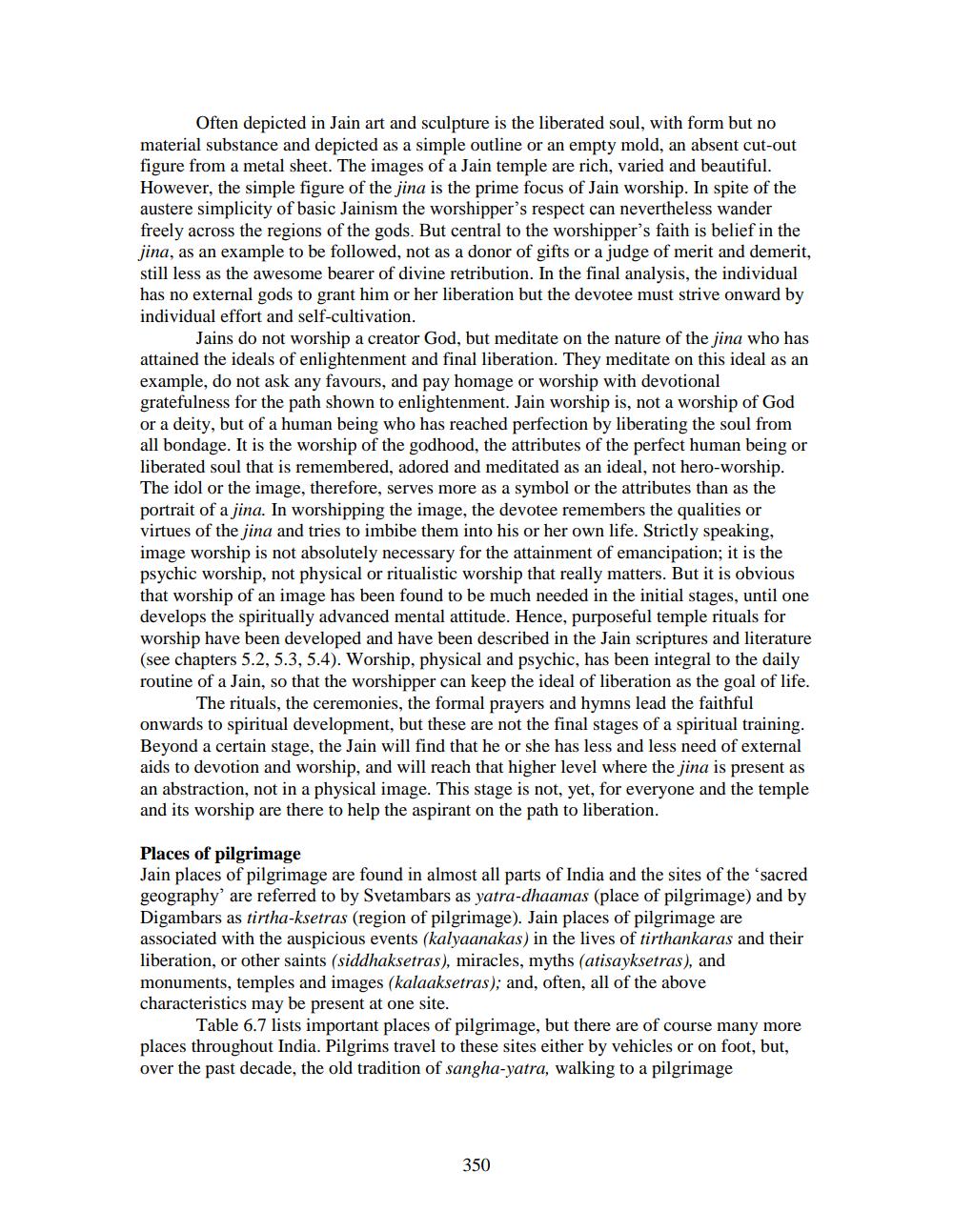________________
Often depicted in Jain art and sculpture is the liberated soul, with form but no material substance and depicted as a simple outline or an empty mold, an absent cut-out figure from a metal sheet. The images of a Jain temple are rich, varied and beautiful. However, the simple figure of the jina is the prime focus of Jain worship. In spite of the austere simplicity of basic Jainism the worshipper's respect can nevertheless wander freely across the regions of the gods. But central to the worshipper's faith is belief in the jina, as an example to be followed, not as a donor of gifts or a judge of merit and demerit, still less as the awesome bearer of divine retribution. In the final analysis, the individual has no external gods to grant him or her liberation but the devotee must strive onward by individual effort and self-cultivation.
Jains do not worship a creator God, but meditate on the nature of the jina who has attained the ideals of enlightenment and final liberation. They meditate on this ideal as an example, do not ask any favours, and pay homage or worship with devotional gratefulness for the path shown to enlightenment. Jain worship is, not a worship of God or a deity, but of a human being who has reached perfection by liberating the soul from all bondage. It is the worship of the godhood, the attributes of the perfect human being or liberated soul that is remembered, adored and meditated as an ideal, not hero-worship. The idol or the image, therefore, serves more as a symbol or the attributes than as the portrait of a jina. In worshipping the image, the devotee remembers the qualities or virtues of the jina and tries to imbibe them into his or her own life. Strictly speaking, image worship is not absolutely necessary for the attainment of emancipation; it is the psychic worship, not physical or ritualistic worship that really matters. But it is obvious that worship of an image has been found to be much needed in the initial stages, until one develops the spiritually advanced mental attitude. Hence, purposeful temple rituals for worship have been developed and have been described in the Jain scriptures and literature (see chapters 5.2, 5.3, 5.4). Worship, physical and psychic, has been integral to the daily routine of a Jain, so that the worshipper can keep the ideal of liberation as the goal of life. The rituals, the ceremonies, the formal prayers and hymns lead the faithful onwards to spiritual development, but these are not the final stages of a spiritual training. Beyond a certain stage, the Jain will find that he or she has less and less need of external aids to devotion and worship, and will reach that higher level where the jina is present as an abstraction, not in a physical image. This stage is not, yet, for everyone and the temple and its worship are there to help the aspirant on the path to liberation.
Places of pilgrimage
Jain places of pilgrimage are found in almost all parts of India and the sites of the 'sacred geography' are referred to by Svetambars as yatra-dhaamas (place of pilgrimage) and by Digambars as tirtha-ksetras (region of pilgrimage). Jain places of pilgrimage are associated with the auspicious events (kalyaanakas) in the lives of tirthankaras and their liberation, or other saints (siddhaksetras), miracles, myths (atisayksetras), and monuments, temples and images (kalaaksetras); and, often, all of the above characteristics may be present at one site.
Table 6.7 lists important places of pilgrimage, but there are of course many more places throughout India. Pilgrims travel to these sites either by vehicles or on foot, but, over the past decade, the old tradition of sangha-yatra, walking to a pilgrimage
350




